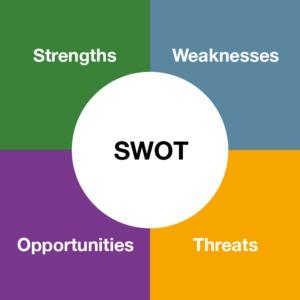How to write a business plan
A robust business plan is crucial to the success of your new business.
A well-written business plan is important when you’re about to start a business.
A business plan is a document that gets to the heart of what your business does, how it works and – most importantly – what makes it different and what will help it succeed.
A good business plan should:
- explain your business objectives;
- be a roadmap that can help you achieve your business objectives;
- highlight potential problems so that you can avoid them impacting on the business;
- identify opportunities and gaps in the market;
- detail shortcomings such as running out of money;
- provide information to help secure a loan or investment.
A business plan should be a living document.
Rather than file it away, use it to monitor progress and keep your new business on track.
Writing your business plan
This guide will help you research and write a good business plan.
It covers presentation and the audience you are writing for, the sections and information to include.
Contents:
- Business Plan Structure – How to structure and order your business plan, and how long it should be.
- How to approach writing a business plan – Writing for your audience and what your plan should include.
- Business objectives – How to define your business goals over the short, medium and long term.
- Skills and experience – How to detail your experience, and how you’ll tackle any skills gaps.
- Target customers – Who your customers are, and what your pricing approach is.
- Market and competitors – How to analyse competitors and identify market trends.
- Sales and marketing – What promotional activities you’ll use to attract customers.
- Operational plans – How to define staffing and premises needs.
- Financials – What financial information to include, such as breakeven points and margin.
- Appendix – What to put in the appendix at the back of your plan.
1. Business plan structure
It’s important to get the structure right.
Make sure your plan is readable, clear, and easy to understand – and base your content on evidence.
To see a detailed example of a business plan structure, download our free business plan template.
- Length – Keep the length to a 15-minute skim read, including only essential information. Put additional detail in the appendix for further reading.
- Executive summary – This appears at the beginning of the Business Plan and should be the last thing you write, summarising everything that is covered in the Business Plan. This includes the business opportunity, customer need, your business proposition and why it will be different in the market.
- Structure – Keep everything simple, using short paragraphs and bullet points, and include relevant graphs and tables, if appropriate. If using statistics, list the source of the information.
- Language – Avoid technical jargon and ‘management speak’, sticking to clear, concise language in plain English. Get a friend to proof read it for spelling errors and to highlight parts that aren’t clear.
Some things are best left out of a good business plan.
Avoid fancy graphics, needless animation and distracting sound effects.
Use readable font sizes – too much small text can make your plan hard going.
2. How to approach writing a business plan
The foundation of any good business plan is research.
You’ll need to find out about your market, calculate revenue forecasts, and learn about target customers.
A good business plan should answer crucial questions about your business.
- Work backwards – Start with your business goals or when you think that your business will start making money, and work back to figure out what you need to do to make your business profitable.
- Be realistic – Make the financials realistic, and look at worse case scenarios so you get a view of what could go wrong and what you would need to do to put things right.
- Be honest – Highlight weaknesses in the market and your business, then detail how you’ll address them and include that in the plan.
- Review the plan – Read the plan from your audience’s perspective, and double-check assumptions. Are they realistic, what could go wrong, and how would you handle a problem that cropped up?
3. Business Objectives
Business objectives summarise what your business does and what it offers.
This section should be no longer than a few paragraphs or a single slide, providing a top-level summary of your business.
- Define your business – What does your business do? What services does it provide? Who will access it and how much will you charge?
- Be specific – Avoid generic, one-word descriptions such as ‘hair dressing’ or ‘plumbing’. For example: Instead of simply writing ‘”Dog grooming“, a better description would be: “This is a mobile dog grooming business, delivering grooming services, nutrition and exercise advice to dog owners throughout Hertfordshire. Our fleet of dog spa vans provide tailored treatments using only organic products to your doorstep.”
- Short term objectives – List what your business will achieve in the next year, or its first year of operation.
- Medium – long term objectives – What are the business goals including financial targets in the next one to two years?
Use S.M.A.R.T. objectives to help set your business goals – Specific, Measurable, Achievable, Realistic and Timely – and list both financial and non-financial goals, such as the impact it will have on customers and how your brand will be viewed.
For help with setting goals, read our guide on setting business aims and objectives.
4. Skills and experience
It’s important to show how your previous experience and skills make you qualified to start your business.
A few lines on your experience and skills is useful here.
It’s a good idea to attach your CV as an appendix to the business plan for additional information too.
Remember to
- List relevant experience that directly relates to the new business, along with key skills that will be helpful for your start up.
- List relevant education, courses and transferrable skills such as bookkeeping or using Microsoft Office. Explain how they’re relevant.
- Be honest about skills and experience that you lack. Explain how you’ll address this, such as training, hiring specialist staff or outsourcing elements of your business.
5. Target customers
Customers are the heart of any business plan.
It’s essential to show that you understand potential customers and know what they’re looking for from your products and services.
There’s a variety of ways to learn about your target customers, including online research, focus groups and surveys.
This information will allow you to choose the right marketing channels to offer the ideal product at the right price.
- Include customer demographics – Summarise gender, age and average income or expenditure.
- Location, location, location – If your business is based on footfall, such as a coffee shop, or it covers a geographic area such as mobile dog grooming, detail the location of your customers. If it’s an online business, your reach might be nationwide, but again show the target demographic, e.g. 18 -30 male and female.
- Addressable market – What is the total size of the customer base that would be interested in your business? For example: The addressable market for a dog grooming business would be all dog owners in the UK that spend money to groom their pets.
- Target market – Within the addressable market, identify the number of customers your business can target. These are customers your business can realistically reach via marketing, and is usually constrained by location, pricing and the reach of your marketing activities.
- Customer segmentation – How would you describe large groups of your customers? What are their characteristics? How do they buy products similar to yours? For example: Dog owners who spend lots on grooming and pet services and are willing to pay for luxury treatments could be labelled ‘pampered owners’. By identifying customer groups, you can develop a service that meets their needs (in this case, luxury dog grooming services) at prices they’re willing to pay.
- Customer need – Explain in a paragraph the problems faced by the customer, what solution your business will provide, and the benefits of that solution to the customer. For example: Many families living in England have children with gluten intolerance who can’t eat the majority of school snacks, and there are few affordable alternatives available. This business helps parents by offering a range of gluten free, affordable school snacks with packaging that’s fun for kids. This results in happy, healthy children and removes the stress parents feel when packing lunchboxes.
- Set pricing – What will your business charge for products and services? Show how you figured out pricing, examining costs and how much customers are willing to pay. Detail how your pricing stacks up against competitors. Is it lower or higher? Why would customers pay more? How can you afford to price it less? Remember being cheaper isn’t always the best way to start a business.
For methods to find out more about your customers, read our guide to market research techniques.
6. Market and competitors
Use your business plan to examine the market that you’ll be operating in.
Knowing what’s happening in your market, which competitors you need to monitor, and their strengths and weaknesses, lets you exploit gaps in the market that will help your business succeed.
This is your chance to show that you really understand your market and ensure your business is able to respond quickly to changing market conditions.
This section should include:
- Market overview – Describe the general market in a few paragraphs, highlighting trends and developments that could be an opportunity. Trends include sales growth, new technology, greater efficiencies or new routes to market. Developments may include new regulation or legal requirements.
- Market research – Describe briefly the research you’ve carried out, such as surveys, online research, mystery shopping or attending trade shows. Please don’t carry out your research with family and friends – use an unbiased source.
- Competitor overview – Who are the main competitors in your market? Write a short summary for each main competitor. You can include details such as market share, their products, pricing, how many customers that you think that they have, and their marketing activity.
- SWOT analysis – For each competitor and your business, conduct a SWOT analysis. This is short for Strengths, Weaknesses, Opportunities and Threats.

What are the strengths and weaknesses of your business? How will you address these? What are the future threats that could hurt your business, and where are there potential opportunities?
It’s worth spending some time thinking about the SWOT analysis, and put the SWOT into the main body of the business plan – even the weaknesses!
- Your unique differentiator – What is different about your business compared to the competitors you’ve listed? What weaknesses does your business exploit and how will that attract customers? Explain how and why your business is different in a paragraph.
7. Sales and marketing
How you position your products or services is critical to its success.
This section of a business plan should explain how you’ll reach your customers, how you’ll sell to customers and your marketing goals.
This section should include:
- How you’ll reach your customers – What marketing channels will you use to reach your customers? Look at where competitors advertise or promote their business. List two or three key channels you can use, and summarise the activity and results you expect these channels to achieve.
- Detail your sales processes – How will you sell your products or services, for example, will you take orders over the internet in a shop or provide quotes for your service personally? What are the costs involved in selling? What is the average revenue per sale that you expect?
- What is your key message? – Examples could be great customer service, more features or a higher-quality product. How will you communicate that message in your marketing activity?
If you’re starting out in marketing and advertising, you can find advice in our guide on how to advertise your business.
8. Operational plans
The operational section concerns how your business will work, what staffing you’ll need, where you’ll operate from, and the suppliers you’ll use.
You’ll need to explain your reasoning behind each one, as well as include details such as salaries and information about your supply chains.
This section should include:
- Supply chain – Good suppliers can help your business grow, while bad suppliers can create cash flow and operational difficulties. Research potential suppliers and shortlist the best. What are the risks in using them,? Create a short list of intended suppliers and the relationship you have with them.
- Management – Identify the key roles in your business during start up. How will you recruit to fill the roles? Create a diagram showing the management structure, and list salaries and recruitment costs. Have they made an investment in the business?
- Staffing – What staff do you need? What productivity do you need from staff, such as the number of customers a staff member can serve in an hour? Provide a summary of the roles, and link to details such as salaries, working hours, activity levels and hiring costs in the appendix.
- IT, systems and machinery – Explain the IT and infrastructure requirements of your business, such as costs involved in buying machinery and IT platforms. How long would development take and cost? Budget for buying office equipment, and include details of information management systems, bookkeeping, stock and quality control systems.
- Premises – Where will your business operate from? Explain your reasoning, including any specialist facilities. If you’re running a business such as a shop, explain why you’ve selected this location. Costs related to premises can be included in the cash flow forecast.
- Legal and regulatory – If applicable, identify any regulatory authorisations, permissions, or requirements that apply to your business, such as planning permission or food safety requirements if opening a restaurant.
- Insurance – What insurance does your business need? Detail who supplies it, what it covers and how much it costs. If you don’t need insurance, explain how you would handle an operational crisis.
- Risks – What could stop your business operating?
9. Financials
Financials underpin your business plan with hard numbers.
If you’re already trading, you’ll be able to use historic revenue data to forecast the profit and loss of your business.
If you’re a start up, you’ll need to explain your assumptions and show evidence in your financial forecasts.
Complete a cash flow forecast and include it in the appendix.
This section should include:
- Show historic figures – If you’re already trading, show your business activity over the past 6 months in an ‘actual’ cash flow.
- Create a one-year forecast – Show all costs the business needs to start up. Include an explanation of key assumptions such as pricing and the cost of equipment or machinery needed.
- Be realistic about funding – Identify the start up costs needed to get your business off the ground. Explain what funding your business will need, what it will be used for, and what type of funding you require. Include repayments of any loans you are intending to take out.
- Risks and exit strategy – What are the risks to your financial assumptions? How will you manage these risks? If it goes wrong, what is your exit strategy from the market?
For help with working out your launch costs, read our guide on how to calculate business start up costs.
10. Appendix
It’s a good idea to put further detail in the appendix, and refer to it throughout the business plan.
Assumptions explained in detail:
- CV and details about senior managers or business owners
- Market research information, such as survey results
- Insurance and regulatory information
- Cash flow forecast
Learn with Start Up Loans and help get your business off the ground
Thinking of starting a business? Check out our free online courses in partnership with the Open University on being an entrepreneur.
Our free Learn with Start Up Loans courses include:
- Entrepreneurship – from ideas to reality
- First steps in innovation and entrepreneurship
- Entrepreneurial impressions – reflection
Plus free courses on climate and sustainability, teamwork, entrepreneurship, mental health and wellbeing.
Disclaimer: The Start -Up Loans Company makes reasonable efforts to keep the content of this article up to date, but we do not guarantee or warrant (implied or otherwise) that it is current, accurate or complete. This article is intended for general information purposes only and does not constitute advice of any kind, including legal, financial, tax or other professional advice. You should always seek professional or specialist advice or support before doing anything on the basis of the content of this article.
The Start-Up Loans Company is not liable for any loss or damage (foreseeable or not) that may come from relying on this article, whether as a result of our negligence, breach of contract or otherwise. “Loss” includes (but is not limited to) any direct, indirect or consequential loss, loss of income, revenue, benefits, profits, opportunity, anticipated savings, or data. We do not exclude liability for any liability which cannot be excluded or limited under English law. Reference to any person, organisation, business, or event does not constitute an endorsement or recommendation from The Start-Up Loans Company, its parent company British Business Bank plc, or the UK Government.
Your previously read articles
Sign up for our newsletter
Just add your details to receive updates and news from Start Up Loans
Sign up to our newsletter


